Ever marvel at the vibrant green of perfectly cooked broccoli or the satisfying crunch of blanched asparagus? That magic doesn’t happen by accident—it’s the result of blanching, a technique every cook, from novice to pro, should master.
Blanching method is one of the most versatile and essential cooking methods. Whether you’re a home cook trying to preserve the color of your veggies or a chef preparing food for a busy service, blanching method is a simple but powerful tool. It’s more than just boiling—it’s a way of creating flavor, texture, and perfection.
What Is Blanching Method?
At its core, blanching method is a moist heat cooking method that briefly immerses food (usually vegetables, fruits, or nuts) in boiling water, followed by an immediate plunge into ice water. This “shock” from hot to cold is what halts the cooking process. It’s not just boiling something—it’s controlling heat to achieve specific results.
Blanching method often serves as a precursor to other cooking stages, like sautéing, freezing, or roasting. It’s the unsung hero behind perfectly peeled almonds, bright green beans, and that satisfying crunch in stir-fried veggies.
Foods frequently blanched include spinach, tomatoes, carrots, green beans, peaches, and more. It serves a functional and aesthetic purpose in the kitchen.
Why Blanch? The Purpose and Benefits of Blanching Method
Blanching method is not just a fancy step to make recipes look more “gourmet”—it’s functional and, when done right, essential. Here’s why blanching deserves a place in your cooking playbook:
1. Preserves Color and Texture
You know that dull, olive-green color overcooked broccoli gets? Blanching method ensures food stays bright and visually appealing, with just the right crunch. Vibrant vegetables, like carrots and snap peas, owe their glow to blanching.
2. Locks in Nutrients
Unlike traditional boiling (which can sometimes seep nutrients into the water), blanching quickly cooks food just enough to preserve essential vitamins. It’s the secret to healthy, nutritious vegetables.
3. Loosens Skins
Struggling to peel tomatoes or almonds? Blanch them! That quick boiling-water bath makes removing skins almost laughably easy.
4. Kills Bacteria and Enzymes
For those freezing bulk vegetables, blanching can kill enzymes and bacteria that cause food spoilage, extending the shelf-life of your favorite greens.
5. Enhances Flavor
Sometimes, blanching improves flavor intensity, making vegetables milder while softening harsh, unpalatable edges. Think of blanched asparagus—slightly tender with a concentrated, earthy deliciousness.
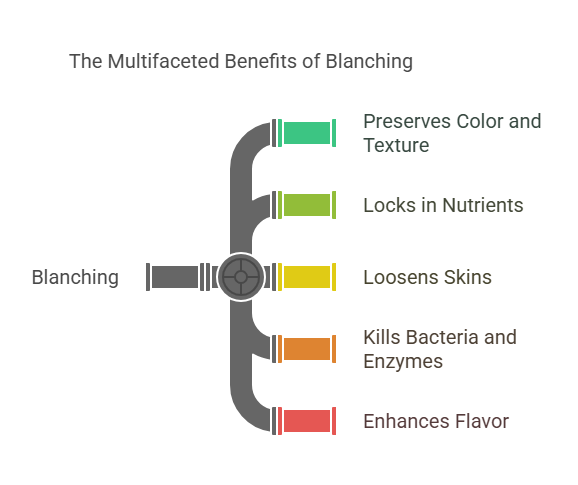
How to Blanch in Five Simple Steps
Mastering blanching comes down to following the right steps, timing perfectly, and avoiding common pitfalls. Here’s how to do it right.
Essential Tools You’ll Need
- A large pot filled with boiling water (to prevent overcrowding).
- A bowl filled with ice water (known as an “ice bath”).
- A slotted spoon or skimmer for easy removal.
- A kitchen timer for precision.
Step 1. Prep Your Ingredients
Start by washing your ingredients thoroughly. Chop, trim, or peel them if necessary. Smaller, evenly-sized pieces will blanch more effectively.
Step 2. Boil Water
Bring a large pot of water to a rolling boil. Salt the water generously—it enhances flavor and helps maintain vibrant color.
Step 3. Blanch the Food
Carefully drop your ingredients into boiling water. Work in small batches to prevent overcrowding (this ensures the water temperature stays consistent). Keep an eye on the clock—here’s a rough guide for common vegetables:
- Green beans: 2–4 minutes
- Broccoli florets: 3 minutes
- Carrots (sliced): 3–5 minutes
- Tomatoes (whole): 30 seconds (to loosen skins)
Step 4. Shock in Ice Water
Once finished, immediately transfer your food to the ice bath. This stops the cooking process, locking in color and texture.
Step 5. Drain and Dry
Remove the food from the icy plunge and drain thoroughly. Pat dry with a clean kitchen towel to avoid sogginess—especially important for freezing or further cooking.
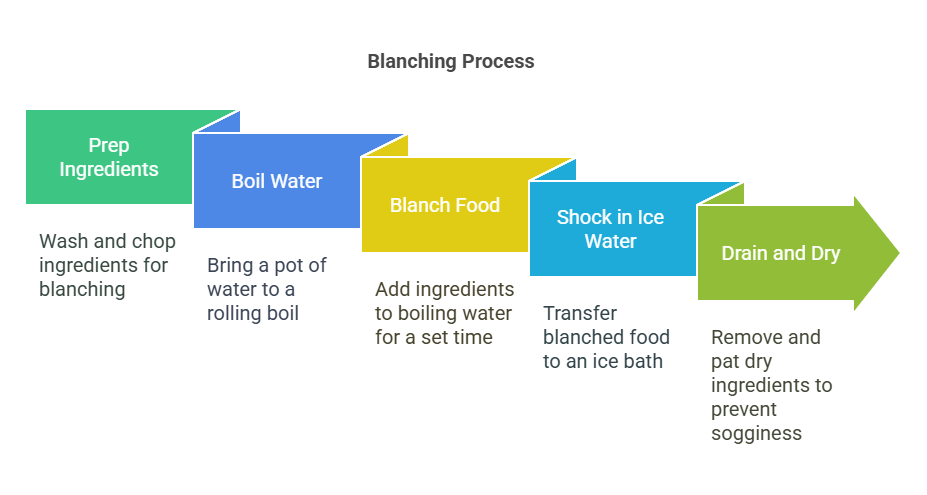
Pro Tips for Perfect Blanching Method
- Timing is everything: Overcooking leads to mushiness, undercooking fails to achieve the desired effects.
- Use salt in boiling water: It boosts flavor and preserves color.
- Keep your ice water just as cold: Dump more ice cubes if needed.
Common Mistakes to Avoid While Blanching
Even a simple process like blanching has plenty of ways to go wrong. Here are the most common missteps to steer clear of:
- Skipping the ice bath: It results in limp, overcooked food, defeating the purpose of blanching.
- Overcrowding the pot: Add only small batches at a time so the water stays at a rolling boil.
- Neglecting to dry: Excess water on blanched veggies can ruin freezing or cooking.
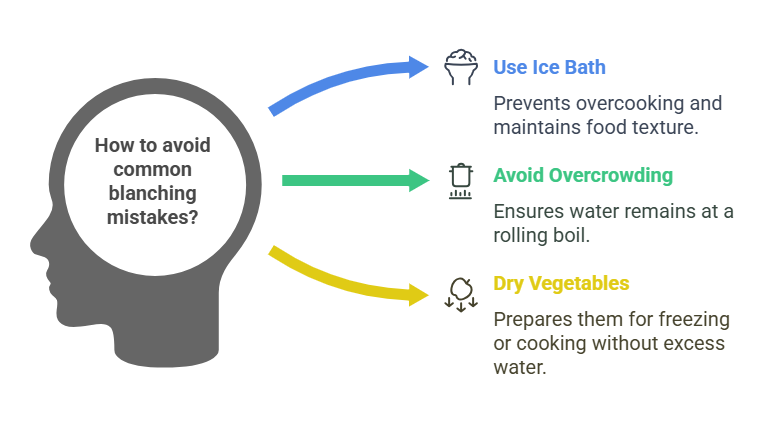
Applications of Blanching Across Cuisines
From culinary novices to Michelin-starred chefs, blanching finds applications in a variety of cuisines:
Western Cuisine
- Preparing blanched asparagus as a side dish.
- Prepping ingredients for roasted casseroles and soups.
Asian Cuisine
- Blanching bok choy and bean sprouts before stir-frying for added texture.
- Parboiling rice noodles to prepare for stir-fries like Pad Thai.
Desserts & Beyond
- Peeling peaches for cobblers.
- Preparing almonds for marzipan or nougat.
Expert Tips for Next-Level Blanching
Once you’ve nailed the basics, here’s how to elevate your blanching game:
- Infused Water for Extra Flavor: Add aromatics like bay leaves, garlic, or rosemary to your blanching water.
- Don’t Be Afraid to Skip: While blanching shines in many dishes, not all veggies need it—raw carrots are an example.
- Perfect Freezing: Blanch vegetables before freezing so they stay fresh and vibrant for months.
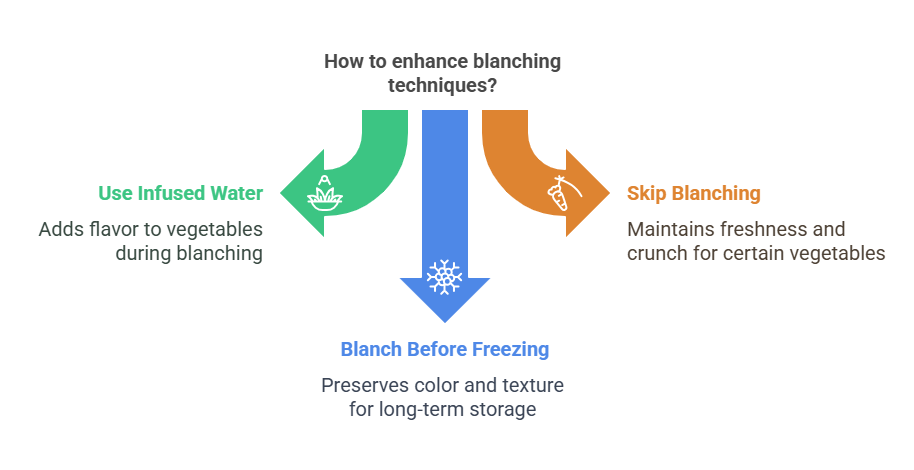
Frequently Asked Questions About Blanching Method
What foods can you blanch?
Virtually any vegetable—think spinach, green beans, broccoli—or even fruits like peaches and tomatoes. You can also blanch nuts, like almonds.
Does blanching cause nutrient loss?
When done correctly (briefly and shocked in ice-cold water), blanching preserves nutrients better than long cooking methods.
What’s the difference between blanching method and boiling method?
Blanching partially cooks ingredients for a specific purpose, while boiling fully cooks food for immediate use as the end result.
Why is an ice bath important?
The ice bath halts the cooking process instantly, ensuring that vegetables retain their vibrant color, crispy texture, and nutrients.
Final Thoughts
Blanching method is more than just a cooking technique—it’s a skill that elevates your dishes, whether for a casual dinner at home or a show-stopping meal for guests. With improved texture, color, and flavor, blanching is a celebration of food at its best.
Now it’s your turn. Grab some fresh veggies, put your blanching skills to the test, and bring your cooking to the next level. Mastering it will make all the difference!
Got any blanching secrets or recipes to share? Drop a comment below!
And for more essential cooking tips, don’t forget to check out our guide on Cooking Methods and Moist Heat Cooking. Happy cooking!
📌 Stay connected with us!
- Follow us on Instagram: @RoastedKitchen25 for daily cooking inspiration.
- Tag us in your creations using #RoastedKitchenBlanching—we’d love to see what you make!
- Subscribe to our newsletter for exclusive recipes, expert tips, and kitchen hacks straight to your inbox!

Hi, I’m Mayaz Ahsan!
As a passionate cook, storyteller, and food enthusiast, I combine my love for travel, farming, reading, and teaching to bring you insightful culinary tips and stories. Welcome to Roasted Kitchen – I’m thrilled to share this journey with you!

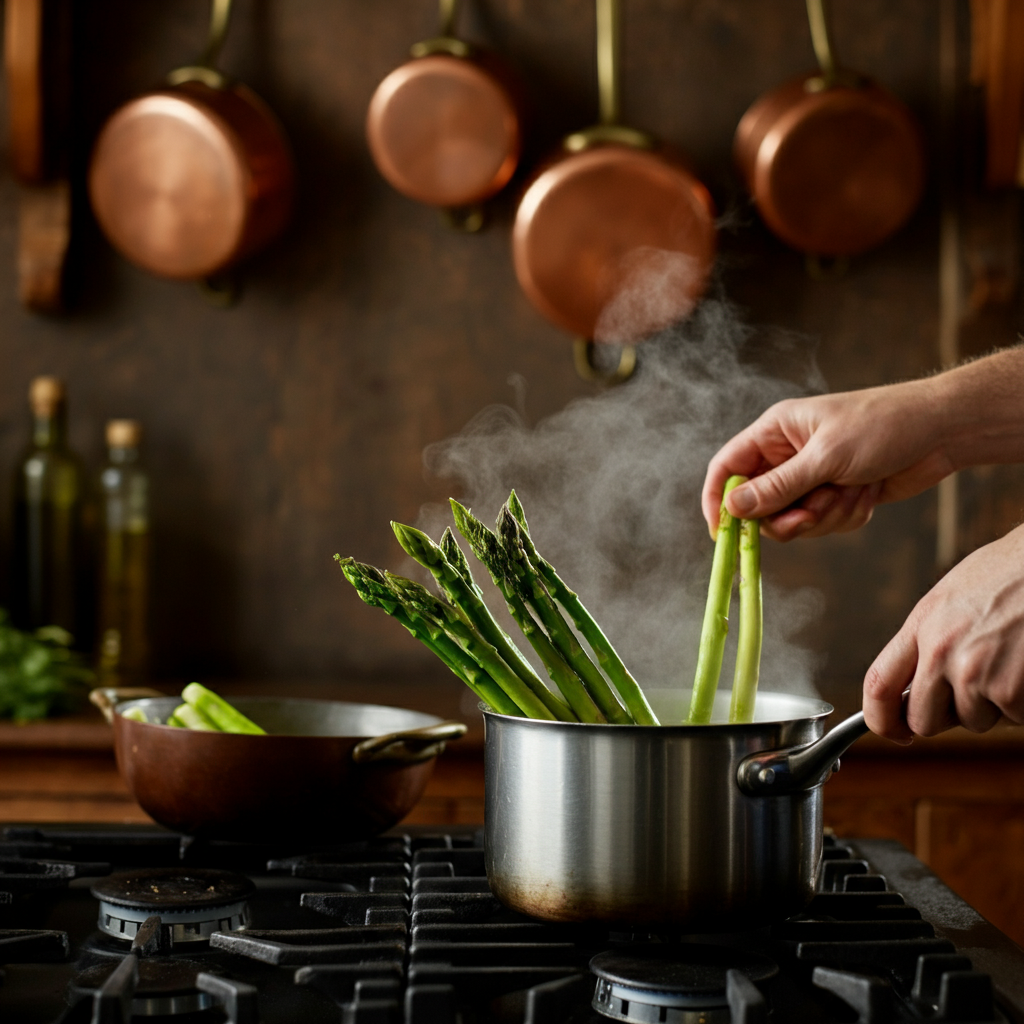








 Subscribe to our free newsletter for tips, tutorials, and insights!
Subscribe to our free newsletter for tips, tutorials, and insights!